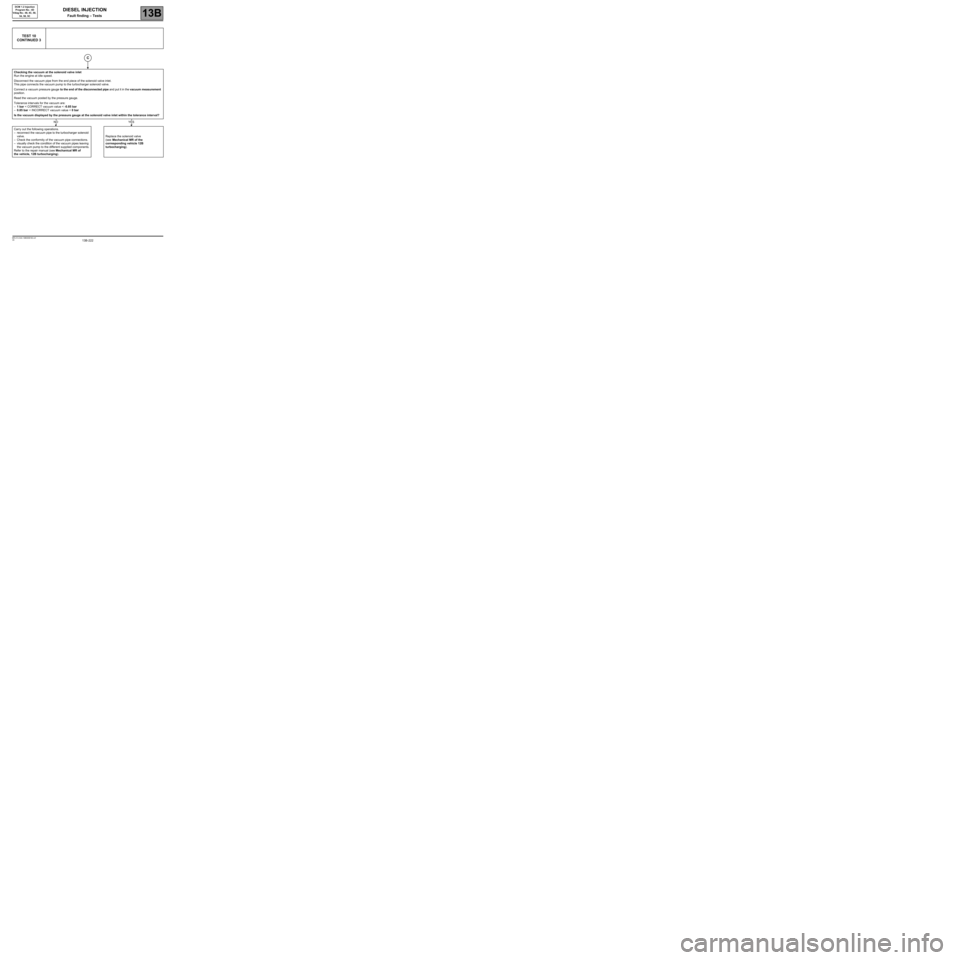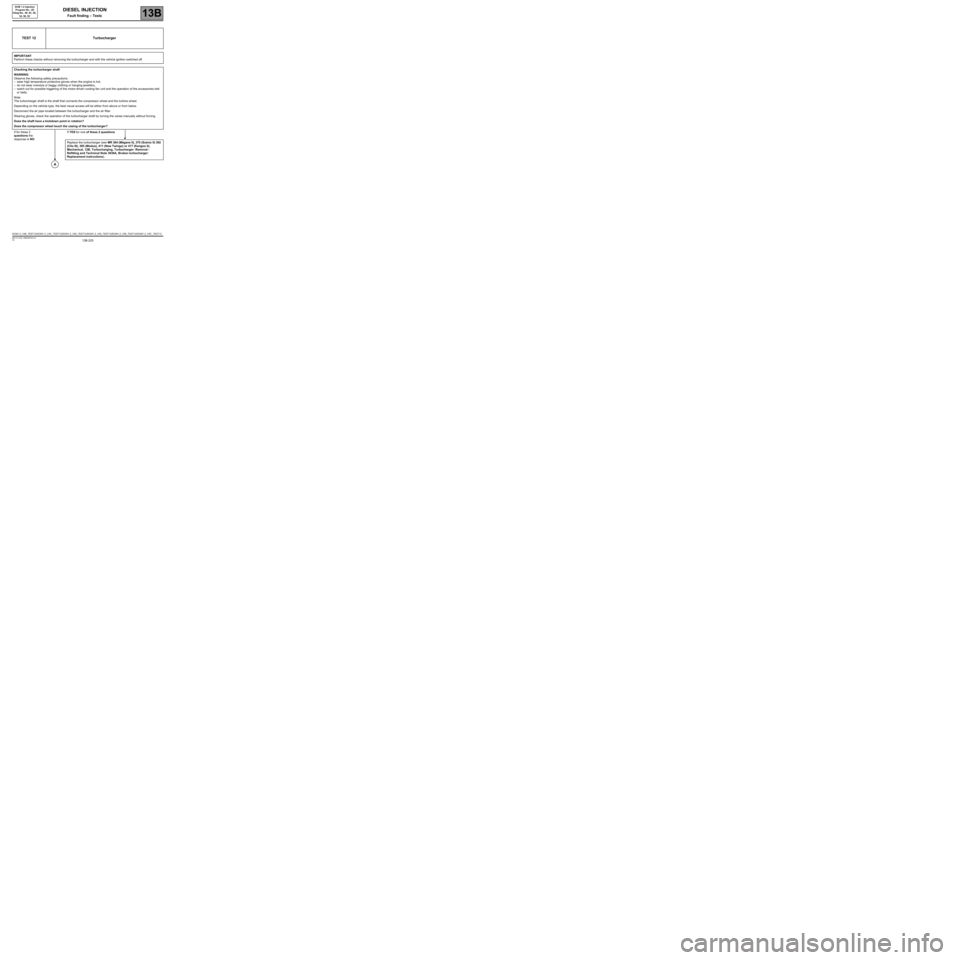2009 RENAULT TWINGO charging
[x] Cancel search: chargingPage 222 of 269

13B-222V6 MR-413-X44-13B000$190.mif
DIESEL INJECTION
Fault finding – Tests13B
DCM 1.2 Injection
Program No.: 4D
Vdiag No.: 48, 4C, 50,
54, 58, 5C
TEST 10
CONTINUED 3
Checking the vacuum at the solenoid valve inlet
Run the engine at idle speed.
Disconnect the vacuum pipe from the end piece of the solenoid valve inlet.
This pipe connects the vacuum pump to the turbocharger solenoid valve.
Connect a vacuum pressure gauge to the end of the disconnected pipe and put it in the vacuum measurement
position.
Read the vacuum posted by the pressure gauge.
Tolerance intervals for the vacuum are:
–1 bar < CORRECT vacuum value < -0.85 bar
–0.85 bar < INCORRECT vacuum value < 0 bar
Is the vacuum displayed by the pressure gauge at the solenoid valve inlet within the tolerance interval?
Carry out the following operations.
–reconnect the vacuum pipe to the turbocharger solenoid
valve.
–Check the conformity of the vacuum pipe connections.
–visually check the condition of the vacuum pipes leaving
the vacuum pump to the different supplied components.
Refer to the repair manual (see Mechanical MR of
the vehicle, 12B turbocharging).Replace the solenoid valve
(see Mechanical MR of the
corresponding vehicle 12B
turbocharging).
C
NOYES
Page 223 of 269

13B-223V6 MR-413-X44-13B000$190.mif
DIESEL INJECTION
Fault finding – Tests13B
DCM 1.2 Injection
Program No.: 4D
Vdiag No.: 48, 4C, 50,
54, 58, 5C
TEST 11 Air line at the turbocharger
Check that the air filter is present.
Check the replacement interval of the air filter on the maintenance booklet.
Compare the part nos. of the fitted air filter on the vehicle and of the air filter recommended by the manufacturer.
Check the direction of fitting of the air filter.
Is the air filter correctly fitted on the vehicle?
Check the condition of the air filter
Visually inspect the condition of the filtering section of the air
filter.
Is the air filter or its seal damaged?
Is the air filter fouled (does it contain a lot of impurities)?Replace the air filter (see MR 364
(Mégane II), 370 (Scénic II), 392
(Clio III), 385 (Modus), 411
(New Twingo) or 417 (Kangoo II)
Mechanical, 12A, Fuel mixture,
Air filter, Removal - Refitting).
Low pressure circuit check
Note:
Depending on the vehicle type, the best visual access will be
either from above or from below.
Visually inspect the condition of the following components:
–fresh air inlet scoop on the front panel of the vehicle,
–air inlet pipe to the air filter,
–air pipe of the filter up to the compressor inlet,
–air flowmeter mountings.
Is one of these components incorrect (pipes dislodged,
torn, bent, pierced or kinked)?Replace the faulty parts (see MR
364 (Mégane II), 370 (Scénic II)
392 (Clio III), 385 (Modus), 411
(New Twingo) or 417 (Kangoo II),
Mechanical, 12B,
Turbocharging).
YESNO
YES
NO
YES
NO
A
DCM1.2_V48_TEST11/DCM1.2_V4C_TEST11/DCM1.2_V50_TEST11/DCM1.2_V54_TEST11/DCM1.2_V58_TEST11/DCM1.2_V5C_TEST11
Page 224 of 269

13B-224V6 MR-413-X44-13B000$190.mif
DIESEL INJECTION
Fault finding – Tests13B
DCM 1.2 Injection
Program No.: 4D
Vdiag No.: 48, 4C, 50,
54, 58, 5C
TEST 11
CONTINUED
High pressure circuit check
Note:
Depending on the vehicle type, the best visual access will be either from above
or from below.
Visually inspect the condition of the following components:
–compressor outlet pipe to the turbocharging air cooler (on some engines,
the turbocharging air cooler does not exist),
–outlet pipe of the turbocharging air cooler to the inlet manifold,
–inlet manifold,
–pressure and temperature sensors.
Is one of these components incorrect (pipes dislodged, torn, bent,
pierced or kinked)?Replace the faulty
parts (see MR 364
(Mégane II), 370
(Scénic II), 392
(Clio III), 385
(Modus),
411 (New Twingo) or
417 (Kangoo II),
Mechanical, 12B
Turbocharging).
Exhaust circuit check
Visually inspect the condition of the following engine sections:
–from the exhaust manifold circuit to the turbocharger turbine,
–from the turbine outlet pipe to the end of the exhaust pipe,
–from the inlet manifold to the EGR valve,
–pressure and temperature sensors connected.
Do certain of these components have blackish or whitish traces?
Run test 10 Turbocharger solenoid valve check.
A
YES
NO
YES
NO
Page 225 of 269

13B-225V6 MR-413-X44-13B000$190.mif
DIESEL INJECTION
Fault finding – Tests13B
DCM 1.2 Injection
Program No.: 4D
Vdiag No.: 48, 4C, 50,
54, 58, 5C
TEST 12 Turbocharger
IMPORTANT
Perform these checks without removing the turbocharger and with the vehicle ignition switched off.
Checking the turbocharger shaft
WARNING
Observe the following safety precautions:
–wear high temperature protective gloves when the engine is hot,
–do not wear oversize or baggy clothing or hanging jewellery,
–watch out for possible triggering of the motor-driven cooling fan unit and the operation of the accessories belt
or belts.
Note:
The turbocharger shaft is the shaft that connects the compressor wheel and the turbine wheel.
Depending on the vehicle type, the best visual access will be either from above or from below.
Disconnect the air pipe located between the turbocharger and the air filter.
Wearing gloves, check the operation of the turbocharger shaft by turning the vanes manually without forcing.
Does the shaft have a kickdown point in rotation?
Does the compressor wheel touch the casing of the turbocharger?
If for these 2
questions the
response is NOIf YES for one of these 2 questions
Replace the turbocharger (see MR 364 (Mégane II), 370 (Scénic II) 392
(Clio III), 385 (Modus), 411 (New Twingo) or 417 (Kangoo II),
Mechanical, 12B, Turbocharging, Turbocharger: Removal -
Refitting and Technical Note 3938A, Broken turbocharger:
Replacement instructions).
A
DCM1.2_V48_TEST12/DCM1.2_V4C_TEST12/DCM1.2_V50_TEST12/DCM1.2_V54_TEST12/DCM1.2_V58_TEST12/DCM1.2_V5C_TEST12
Page 226 of 269

13B-226V6 MR-413-X44-13B000$190.mif
DIESEL INJECTION
Fault finding – Tests13B
DCM 1.2 Injection
Program No.: 4D
Vdiag No.: 48, 4C, 50,
54, 58, 5C
TEST 12
CONTINUED 1
Checking the condition of the turbocharger vanes.
Note:
This check is facilitated by using a mirror and a bulb.
Depending on the vehicle type, the best visual access will be either from above or from below.
Visually check that the compressor vanes are in good condition.
Are the vanes damaged or twisted?
Replace the turbocharger (see MR 364 (Mégane II), 370
(Scénic II), 392 (Clio III), 385 (Modus), 411
(New Twingo) or 417 (Kangoo II), Mechanical, 12B
turbocharging, Turbocharger: Removal - Refitting
and Technical Note 3938A, Broken turbocharger:
Replacement instructions).
Which type of turbocharger is it?
Variable geometry
turbochargerFixed geometry
turbocharger
A
NO
YES
BC
Page 227 of 269

13B-227V6 MR-413-X44-13B000$190.mif
DIESEL INJECTION
Fault finding – Tests13B
DCM 1.2 Injection
Program No.: 4D
Vdiag No.: 48, 4C, 50,
54, 58, 5C
TEST 12
CONTINUED 2
Checking the turbocharging pressure regulator to determine if it is a variable geometry turbocharger
Note:
The pressure regulator rod of a variable geometry turbocharger is orthogonal to the turbocharger shaft.
Variable geometry turbochargers are controlled by a solenoid valve.
Depending on the vehicle type, the best visual access will be either from above or from below.
Note:
If necessary, according to the vehicle type and the accessibility of the pressure regulator, connect the vacuum
pump to the end of the pressure regulator pipe at the solenoid valve outlet.
Using a manual vacuum pump, apply a vacuum on the turbocharging pressure regulator of approximately
650 mbar.
1. Check that the fitting is completely leaktight.
2. Check that the control rod is resting against its stop.
3. Lock the vacuum device and check that the pressure variation is not greater than 100 mbar in 10 seconds.
4. Release the pressure and check that the control rod comes back to its initial position without jerking.
Repeat the complete sequence 3 times.
Is the pressure regulator leaktight and is the rod movement correct?
The turbocharger is correct.
End of procedure.Replace the turbocharger (see MR 364 (Mégane II), 370
(Scénic II), 392 (Clio III), 385 (Modus), 411 (New Twingo)
or 417 (Kangoo II), Mechanical, 12B turbocharging,
Turbocharger: Removal - Refitting and Technical Note
3938A, Broken turbocharger: Replacement instructions).
B
YESNO
Page 228 of 269

13B-228V6 MR-413-X44-13B000$190.mif
DIESEL INJECTION
Fault finding – Tests13B
DCM 1.2 Injection
Program No.: 4D
Vdiag No.: 48, 4C, 50,
54, 58, 5C
TEST 12
CONTINUED 3
Checking the turbocharging pressure regulator to determine if it is a fixed geometry turbocharger
Note:
The pressure regulator rod of a fixed geometry turbocharger is aligned with the turbocharger shaft.
Fixed geometry turbochargers are controlled by a solenoid valve.
Depending on the vehicle type, the best visual access will be either from above or from below.
Note:
If necessary, according to the vehicle type and the accessibility of the pressure regulator, connect the vacuum
pump to the end of the pressure regulator pipe at the solenoid valve outlet.
Using a manual vacuum pump, apply a vacuum on the turbocharging pressure regulator of approximately
650 mbar.
1. Check that the fitting is completely leaktight.
2. Check that the control rod moved several millimetres.
3. Lock the vacuum device and check that the pressure variation is not greater than 100 mbar in 10 seconds.
4. Release the pressure and check that the control rod comes back to its initial position without jerking.
Repeat the complete sequence 3 times.
Is the pressure regulator leaktight and is the rod movement correct?
The turbocharger is correct.
End of procedure.Replace the turbocharger (see MR 364 (Mégane II), 370
(Scénic II), 392 (Clio III), 385 (Modus), 411 (New Twingo)
or 417 (Kangoo II), Mechanical, 12B turbocharging,
Turbocharger: Removal - Refitting and Technical Note
3938A, Broken turbocharger: Replacement instructions).
C
YESNO
Page 253 of 269

13B-253V6 MR-413-X44-13B000$210.mif
DIESEL INJECTION
Fault finding – Fault finding charts13B
DCM 1.2 Injection
Program No.: 4D
Vdiag No.: 48, 4C, 50,
54, 58, 5C
In this case, the lack of power is due to insufficient vacuum for the OCR * setpoint given.
ALP11 Loss of power
NOTESSpecial note:
Only consult this customer complaint after a complete check with the diagnostic tool.
See explanation for flow capacity function in system operation.
There is no turbocharging control solenoid valve on New Twingo K9K 740
engines or on Kangoo 2 K9K 800 engines.
Is the "Flow capacity function" programming
active?Check the diesel filter.
Is it close to the replacement mileage?
Using the diagnostic tool, check that the injector
codes (C2I) are correctly entered on the identification
screen. If not, configure the correct injector codes
using command SC002 Enter injector codes.Replace the diesel filter (see MR 364
(Mégane II), MR 370 (Scénic II), MR 385
(Modus), MR 392 (Clio III), MR 411
(New Twingo), MR 417 (Kangoo 2),
Mechanical, 13A, Fuel mixture, Fuel
filter: Removal - Refitting).
Check the air inlet circuit: run TEST 5 Air inlet circuit
check.
YES
NO
NO
YES
A
DCM1.2_V48_ALP11/DCM1.2_V4C_ALP11/DCM1.2_V50_ALP11/DCM1.2_V54_ALP11/DCM1.2_V58_ALP11/DCM1.2_V5C_ALP11